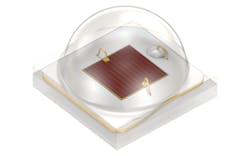Osram announces packaged LEDs for horticulture and auto headlamps
Osram Opto Semiconductors has added to its horticultural lighting LED portfolio with an improved model of its Oslon Square Hyper Red series that delivers horticultural efficacy around 4 µmol/J. In the automotive sector, the company has a new LED called the Oslon Boost HM delivered in a small-footprint package that will enable ultraslim headlamps on vehicles.
Generally, the LED companies start the year a bit slowly and crank up their product launches in late January and early February, especially headed into Strategies in Light. Osram has certainly broken that norm this year, having announced new color LEDs for digital projectors last week and now horticultural and automotive LEDs this week. The three announcements do all share the element of extremely high energy output in the application at hand.
Auto styling
Osram led the automotive press releases stating that “light is the new chrome for cars.” And indeed, we heard similar themes from a number of the auto exhibits at CES last week. Advanced lighting both on the exterior and in the cabin has become a key selling feature for automakers.
And just as in other lighting applications, the small form factor afforded by LEDs can be utilized to create style. As the nearby photo suggests, headlamps based on the Oslon Boost HM just don’t look anything like legacy headlamps and can instead take on a slim and even curved look that will be instantly recognizable.
The key to such designs is, of course, the size of the component and the ability to deliver high lumen output from that small package. The Oslon Boost HM occupies a 1.9×1.5-mm footprint and stands just 0.73 mm high. The LED chip area measures just 0.5 mm on a side, yet the LED can deliver 415 lm at 1.5A. The design delivers luminance of 255 cd/mm2.
“With the Oslon Boost HM, we are not only expanding our Oslon Boost product family to include particularly high luminance levels but are also helping our customers create ultraslim headlamp designs,” explains Florian Fink, marketing manager for automotive exterior at Osram. “Thanks to our products, future vehicles will feature a new face.”
The company said the key to the performance is a ceramic package that minimizes thermal resistance, specified at 4.62 K/W. Osram said the LED can be used in standard headlamps, as well as in designs with an adaptive high beam relying on MEMS (microelectromechanical systems) technology.
Horticultural lighting
Moving to the horticultural space, Osram has extended the performance of its Oslon Square Hyper Red to deliver PPF (photosynthetic photon flux) of 5.7 µmol/s when driven at 700 mA. The new 660-nm Oslon Square Hyper Red, like the model it replaces, is intended for use in horticultural lighting systems that deliver doses of red and blue light, two spectra that typically nurture the growth of various plants and crops such as tomatoes by abetting chlorophyll absorption.
Energy at 660-nm wavelengths can lead to increased biomass in plants and more efficient flowering, as we wrote after a presentation at our third Horticultural Lighting Conference. That event has been renamed to the HortiCann Light + Tech Conference and the 2020 event will be held on Oct. 20 in San Jose, CA, located in the heart of Silicon Valley.
Osram designed the new chip and its packaging with same footprint size as the earlier edition so as to make it easy for existing users to replace the old with the new. Both measure 3 mm per side. The primary improvements in the new Hyper Red LED are higher flux output and efficiency. The new model radiates more energy — with a radiant flux of 1.03W compared to the earlier 965 mW, translating to the aforementioned 5.7 µmol/s versus 5.3 µmol/s for the prior version.
Osram rated the “wall plug efficiency” at 73%, an improvement over 66% for the prior version. Wall plug efficiency is a raw measure of efficiency in terms of energy produced. The new LED delivers even better efficiency at lower drive currents — 78% at 350 mA or even 80% at 250 mA.
Of course, neither plants, nor human eyes, react to wall plug efficiency. But the horticultural efficacy metric translates directly to efficiency for plants. The 1.03W flux translates to a photon-flux or horticultural efficacy of 4 µmol/J for the new model compared to the earlier 3.6 µmol/J. At the reduced 250-mA drive current, that efficacy climbs to 4.6 µmol/J.
“Horticulture lighting is an absolute growth market, which we have been leading for many years by providing more and constantly improved products,” said Yong Sheng Chew, product manager at Osram. “The significantly improved efficiency values help our customers save energy. Thanks to the proven compact footprint of 3.0×3.0 mm, greenhouse owners can easily bring existing lighting systems up to date with the latest LED technology.”
Luminaire makers and growers can include the chip in tunable systems that adjust the brightness levels of red, blue, and other frequencies. The 660 nm is a fixed red frequency and cannot be shifted to other wavelengths in the red spectrum. Osram declined to reveal pricing for the new chip.
Horticulture is one market segment that holds great promise for a lighting industry that has struggled to find a profitable business model now that LEDs and their long lifetime have gone mainstream as illumination sources and undermined that age-old certainty of selling replacement bulbs. By tailoring light frequencies to the optimal levels for different crops and plants, growers can potentially greatly improve their yields and quality.
Osram has been busily addressing that market. Last June, it introduced the Duris S5 family of chips, including a line that combines red and blue frequencies for purple light, and another that plays with phosphor-converted white LEDs to deliver more far red energy.
In March, it introduced the Phytofy system for mixing and matching six spectral channels. A few months earlier, Osram released a near-infrared chip which when installed in a smartphone can help farmers know precisely when a fruit or cereal crop is ready for harvest.
In the spring of 2018, Osram acquired Austin, TX-based smart LED grow-light system maker Fluence Bioengineering, a few weeks before investing in Motorleaf, a Canadian startup that makes software to predict yields of crops like tomatoes and cannabis.
End users of Osram horticultural products have included Italian basil grower Servizi Ambientali Bassa Reggiana, among others.

Mark Halper | Contributing Editor, LEDs Magazine, and Business/Energy/Technology Journalist
Mark Halper is a freelance business, technology, and science journalist who covers everything from media moguls to subatomic particles. Halper has written from locations around the world for TIME Magazine, Fortune, Forbes, the New York Times, the Financial Times, the Guardian, CBS, Wired, and many others. A US citizen living in Britain, he cut his journalism teeth cutting and pasting copy for an English-language daily newspaper in Mexico City. Halper has a BA in history from Cornell University.






